There is so much to see and do in Thailand that few visitors can resist returning. With an expansive coast line and gorgeous tropical islands, Thailand is justly famed for its wonderful beaches and laid-back lifestyle. Inland, there are the iconic sights of lush jungles, rolling hills and rice paddies. As a country of Buddhists, there is also an abundance of golden temples and beautiful, spiritually-inspired architecture. One word of caution though: to avoid the common fate of temple fatigue, visitors shouldn't try to see too many. They should rather concentrate on a few key attractions and spend some quality time in each of them.In contrast is the buzzing atmosphere of Bangkok, whose neon lights and smoggy streets blend with gardens and floating markets to create a unique hybrid of old and new - at a frenetic pace.One reason why Thailand is such a rewarding sightseeing destination is that it has retained its distinctive identity in the face of significant western influence. That makes visiting here an exciting and exotic experience, whether travellers are resort-loving beach bums or adrenaline junkies exploring hill tribes and river rapids. More good news is that Thailand is blessed with year-round temperate weather, so travellers can visit at any time - although in the months from June-October, rough sea conditions may make some islands unreachable via the ferry system.Getting around is fairly easy and remarkably safe. An excellent bus network connects even far-flung towns with the major cities, while a comfortable sleeper train connects Chiang Mai in the far north with the capital Bangkok. Many people prefer to see the sights via organised tours and air-conditioned buses, but by doing so visitors risk missing out on the fun of getting between attractions, where they will encounter local people in unexpected ways.
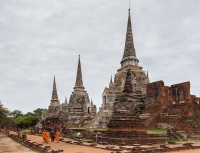
Ayutthaya is the former capital of Siam, from 1350 until mid-18th century, and at one time was one of the largest cities in the world. The capital was relocated to Bangkok in 1768 when the Burmese army destroyed much of Ayutthaya. Today, tourists needn't imagine too much to experience the splendour of the old capital, as many of the enormous structures are still there, and the ruins of Ayutthaya have been designated a UNESCO World Heritage Site. Multiple buses (a trip that takes a bit over an hour) and trains arrive daily from Bangkok and a boat up the Chao Phraya River to Ayutthaya can be organised through travel agencies. Although many organised tours in Thailand can be a frustrating experience, a tour guide here can give some fascinating history to the already impressive wats. This is an easy way to experience some of the ancient history of Siam as Bangkok is relatively new.
Address : At the junction of the Chao Phraya, Lopburi and Pa Sak rivers
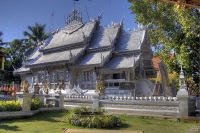
Temple tours of Chiang Mai are a wonderful attraction for visitors. The old town is home to the most honoured temples and some tranquil Buddhist sanctuaries. The historic Wat Pra Singh holds the revered Phra Singh Buddha, which possibly dates from the 14th century. The oldest temple in Chiang Mai is Wat Chiang Man (established by King Mengrai), noted for its ancient bas reliefs and massive teak columns. Wat Chedi Luang boasts a gigantic chedi ruin, said to be the tallest structure in the old town, and was once home to the sacred Emerald Buddha (now in Bangkok).
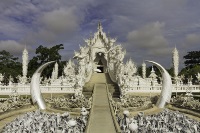
Nestled into the lush mountains of northernmost Thailand, Chiang Rai is a hotspot for travellers who want to get a real cultural experience from their stay in Thailand. The region is home to the remote hill tribe communities that make up about 10 percent of Thailand's population. Scattered through the mountains and valleys of the province, the tribes are descendents of nomadic peoples from Tibet and southern China. Each tribe is unique, with its own colourful culture and traditions. Many travellers arrive in Chiang Rai from Chiang Mai (a three-hour bus journey) to begin their treks to hill tribe villages, but there is plenty to see and do in Chiang Rai itself including many beautiful temples and interesting museums. Visitors will also find good restaurants and food stalls offering a taste of northern Thai cuisine. The city has a lively, if not endless, nightlife, with a few good bars and pubs hosting live music. Chiang Rai is situated near the coming together of the three modern nations of Thailand, Myanmar and Laos, a region known as the Golden Triangle, which is dissected by the mighty Mekong River.
Transport : Chiang Rai is 3-4 hours by bus from Chiang Mai
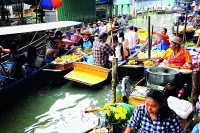
The Damnoen Saduak Floating Market is an escape from the Western-style shopping malls of Bangkok and a glimpse into the past, revealing the centuries-old way of life of the residents whose stilt-houses perch on the canals and make their living selling fruits, vegetables and flowers. Visitors can explore the market with boat trips and sample the wares of local farmers as they do so. They can also enjoy the experience of floating through one of Thailand's many river villages.
Transport : Bus 78 from Bangkok Southern Bus Terminal to Damnoen Saduak Bus Terminal.
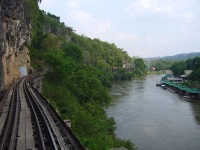
Located 89 miles (143km) west of Bangkok, the town of Kanchanaburi has secured its position of infamy as the original site of the Bridge Over The River Kwai, where during World War II allied prisoners of war were used by the Japanese to build the Death Railway, killing thousands in the process. With its modern hotels and welcoming air, Kanchanaburi seems an unlikely setting, but the bridge is still in use and the graves of the Allied soldiers are testament to the town's unfortunate past. Worth a visit is the JEATH (Japan, England, Australia/America, Thailand and Holland) War Museum in Kanchanaburi, which recounts experiences in the Japanese POW camps during the War. The Sai Yok Yai Waterfall in the Sai Yok National Park is a place of idyllic beauty and makes a good excursion from Kanchanaburi; the falls are widely celebrated in Thai poetry and songs. The turquoise waters of Erawan Falls are also reachable from Kanchanaburi as an interesting day trip.
Website : www.kanchanaburi-info.com
Located 83 miles (135km) up a coiled mountain road from Chiang Mai in the extreme northwest of Thailand, Pai is an unlikely tourist attraction. The town has undergone a number of transitions from hill tribe village to hippie hideaway to a tourist playground. Its relaxed atmosphere and peaceful mountain scenery have enlarged its widening reputation and it is now a tourist hot spot. Pai is a popular base camp for treks into the hills which can be arranged through hotels or travel agencies in the city. Closer waterfalls and hot springs are worth a visit, and elephant camps are nearby as well. An airport now connects Pai to Chiang Mai, but the best way to get there is by motorbike or bus in order to see the beautiful scenery on the way.
Address : 83 miles (135km) from Chiang Mai
The holiday spot of Phang Nga Bay is characterised by sheer limestone cliffs that jut vertically out of the emerald green water. The bay contains a fascinating collection of 3,500 islands, most of them uninhabited, which are unique in that they have central hollows or 'rooms', actually collapsed cave systems, containing hidden realms of unspoilt fauna and flora. Many of these can only be reached by inflatable kayak, which makes exploring the bay on the water an exciting way to enjoy the spectacular scenery. The largest and most popular Phang Nga Bay islands are James Bond Island and Koh Pannyi, the first named for having been where the movie The Man with the Golden Gun was filmed. Koh Pannyi or Sea Gypsy Island is where a village has been built on stilts in the water with a giant monolithic rock guarding its rear. Regular boat trips carry holiday tourists from Phuket to Phang Nga Bay, and it can be overcrowded during high season.
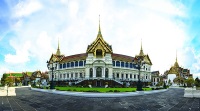
The Royal Grand Palace is a popular Bangkok attraction. Construction of the palace began in 1782 and was completed in time for the coronation of King Rama I, and opened in 1785 to signify the end of the Burmese invasion of Thailand. The palace itself is made up of a complex array of smaller buildings, most notably the Wat Mahatat (the Palace Temple) and the Wat Phra Keow (the Royal Chapel), which houses the famous Emerald Buddha sculpted from a single piece of jade, one of the most revered objects in Thailand.
Address : Na Phralan Road, Phra Nakhon
Opening times : Open daily 8.30am - 3.30pm
Admission : THB 500
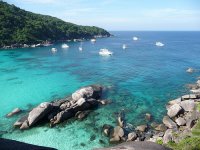
The Similan Islands have a reputation, even among the many Thai islands, as one of the world's top scuba diving sites. The intense blue waters are framed by white coral sand beaches, and are home to intricate coral reefs and rock formations. The most famous dive site in the Similan Islands is Richelieu Rock, where whale sharks are commonly spotted. The Similan archipelago consists of nine islands: Ko Bon, Ko Bayu, Ko Similan, Ko Payu, Ko Miang, Ko Payan, Ko Payang, and Ko Huyong. Not all are open to visitors, and all are virtually uninhabited. Many charters offer day trips to the Similan Islands from Phuket and Phang Nga, but there are limited accommodation opportunities as well. Note that the park is closed from May 1st to November 1st every year, and it is illegal to visit during this period; guests who do so put their lives at risk as there are is no emergency support.
Website : www.similans.net
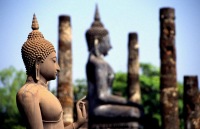
Now a small city in southern Thailand, Sukhothai was once the seat of an ancient Siamese culture. The Sukhothai National Historic Park has been named a UNESCO World Heritage Site, and is dedicated to preserving the area's many temples, palaces and monuments, which date back to the 13th century. The old city covers roughly 27 square miles (70 sq km) and is divided into three zones, each of which charge separate admission. There are bicycle rentals available, and there is a privately-run tour by tram. New Sukhothai, 7.5 miles (12km) from the historic park, features a fresh market with great local food, and a few shops and restaurants.
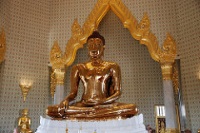
Dating back to the 13th century, the buddha at Wat Traimit stands nearly 10 feet (3m) tall, weighs over five tons and is believed to be solid cast gold, the largest gold statue in the world. It was discovered by accident in 1957 when an old stucco image was dropped by a crane, shattering the plaster shell to reveal the brilliantly shining gold underneath. The statue is breathtaking and is thought to have come from Ayutthaya covered in plaster to hide it from the Burmese invaders.
Address : Traimit Rd

Travel Guide powered by Word Travels, copyright © 2023 Globe Media Ltd. By its very nature information in this travel guide is subject to change at short notice and travellers are urged to verify information on which they're relying with the relevant authorities. Neither Globe Media Ltd nor Travel Vogue can accept any responsibility for any loss or inconvenience to any person as a result of information contained above.